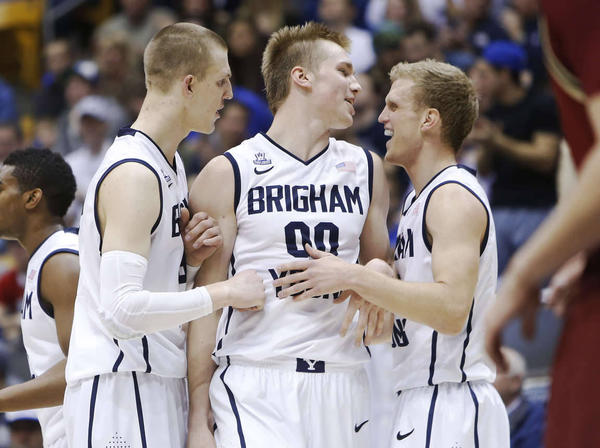Increasingly Balanced WCC Could Have Bright Future Ahead
Posted by Bennet Hayes on March 10th, 2014Let’s play a little word association game. I say WCC, you say… Gonzaga – right? But when I say Gonzaga, there are bound to be a dozen or so words that will escape your lips before you say WCC. This only makes sense, because for as long as anyone can remember, Gonzaga has been the WCC. Or, at the very least, that interchangeability has served as a quick and easy (and fairly accurate) mental shortcut. But here in 2013-14, the times are a changin’ as Gonzaga has shown more fragility than it has in a long while, but more importantly, the rest of the conference has taken a significant step forward.

BYU Is A Big Part Of The More Balanced West Coast Conference We Have Seen This Year. The Cougars Are Also One Of Many WCC Teams That Should Be Even Better In 2014-15.
That pairing of Zag vulnerability and WCC uprising was on full display Saturday night in the WCC quarterfinals, where a Santa Clara team that finished eighth in the league pushed Mark Few’s team to the final buzzer. Gonzaga managed to narrowly escape the Broncos’ challenge (on a David Stockton coast-to-coast layup in the final seconds) and is still the clear favorite to take the WCC Tournament title this week, but are these more balanced days here to stay and flourish in the WCC?
The WCC will likely only send two teams to the 2014 NCAA Tournament (an outside shot at three if Saint Mary’s or San Francisco can steal the WCC Tournament title), but even with Gonzaga slightly down, the league has been better than it has been in a very long time. Their current conference RPI and KenPom ranking of #9 is the best since the 2004-05 season, and there may be even better days ahead. Saint Mary’s core of seniors leaves Randy Bennett’s team vulnerable to a significant drop-off next season (the SMC situation almost demands its own post, honestly), but outside of the Gaels and a senior-laden Pacific team, most every WCC team will return the bulk of its core. The young nuclei around the league have all had their moments this season, and coaching staffs at Pepperdine, San Diego, Portland, Loyola Marymount and Santa Clara should all be expecting improved teams to return in 2014-15.
With so many contributors returning throughout league rosters, even the elite will struggle to find easy wins on their schedule next winter. But the middle of the conference won’t be the only grouping of WCC squads with a rosier outlook. San Francisco, BYU and Gonzaga – all top-three seeds in this year’s WCC Tournament — should be even better. The Dons lose only one rotation player in senior Cole Dickerson, while a senior-less BYU roster (yes, really) should return intact save for stud freshman Eric Mika, who has said he will serve his Mormon mission after the season. And while Gonzaga may be watching everyone around it grow stronger, there’s no reason to believe that the Zags will be evacuating its lofty perch anytime soon. Sam Dower, David Stockton and Drew Barham will all be gone after this season, but the arrivals of Kentucky transfer Kyle Wiltjer and highly touted freshman Josh Perkins should aid a talented returning cast in keeping the Zags nationally relevant. More balance is undoubtedly a good thing for the WCC, but having a strong Gonzaga program carrying the flag is equally important. The 2014-15 season should feature both attributes.
The WCC’s rock-solid 2013-14 campaign came at a good time. Unseating the Pac-12 as the West Coast’s premier basketball conference may be the stuff of pipe dreams, but the struggles of the Mountain West leaves a bit of an opening on which the WCC can capitalize. A year after leading the nation in conference RPI, the MW is now behind the WCC in 10th place. The Mountain West should be poised for a rebound next season, but the WCC’s potential for growth makes it no certainty that its rival league will regain its standing as the second best conference in the West – and not just next year, but beyond. The complete and utter dismantling of the WAC also aids a possible WCC ascension. When you see Utah Valley winning the league’s regular season title it may be easy to forget this, but for much of the late 90s and early 2000s, it was the WAC that stood as second in command among West Coast conferences. Needless to say, it is no longer a factor in that discussion, and many of their resources (both programs and recruits) have been redistributed throughout the Pac-12, MW, and WCC.
The WCC is largely made up of small, private schools. This member archetype may be seen as an obstacle to building a dominant athletic conference, but it’s not especially distant from the current Big East blueprint. What’s more, we have already seen the heights that a small WCC school (Gonzaga’s undergraduate enrollment is less than 5,000, and St. Mary’s has fewer than 1,500 undergraduates) can rise to, so why would building a program be impossible at USD, Pepperdine, or USF? It shouldn’t be, especially if more talent and an improving level of play supply the league an elevated level of prestige in coming years. As for this year, Gonzaga and BYU will likely be the sole WCC representatives in the NCAA Tournament. Two bids on Selection Sunday is far from embarrassing for a league outside the power conference group of seven, but with a deeper, more balanced WCC brimming on the horizon, the conference can fairly dream of an even more substantial role in future bracket unveilings.











































